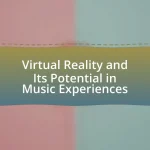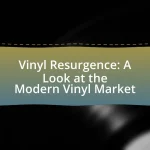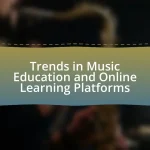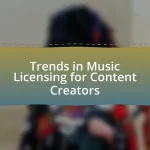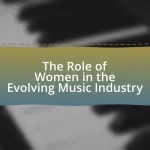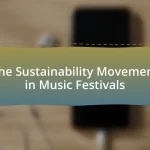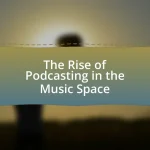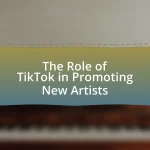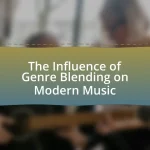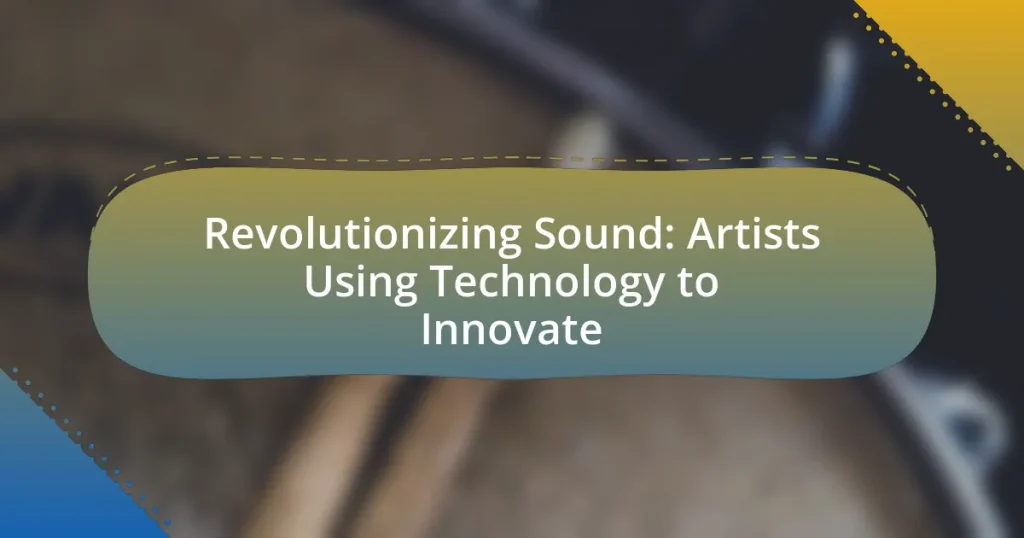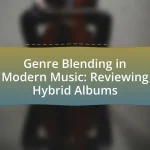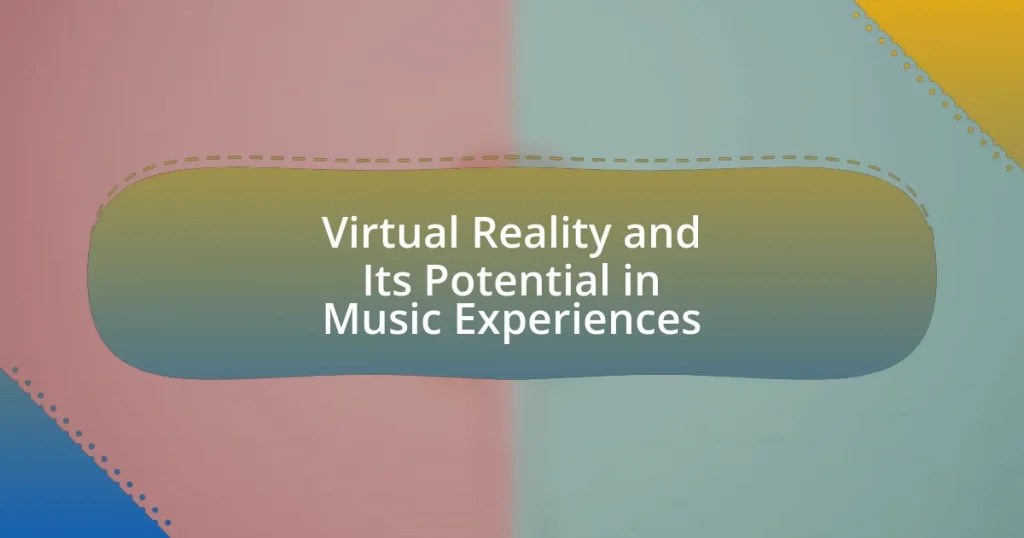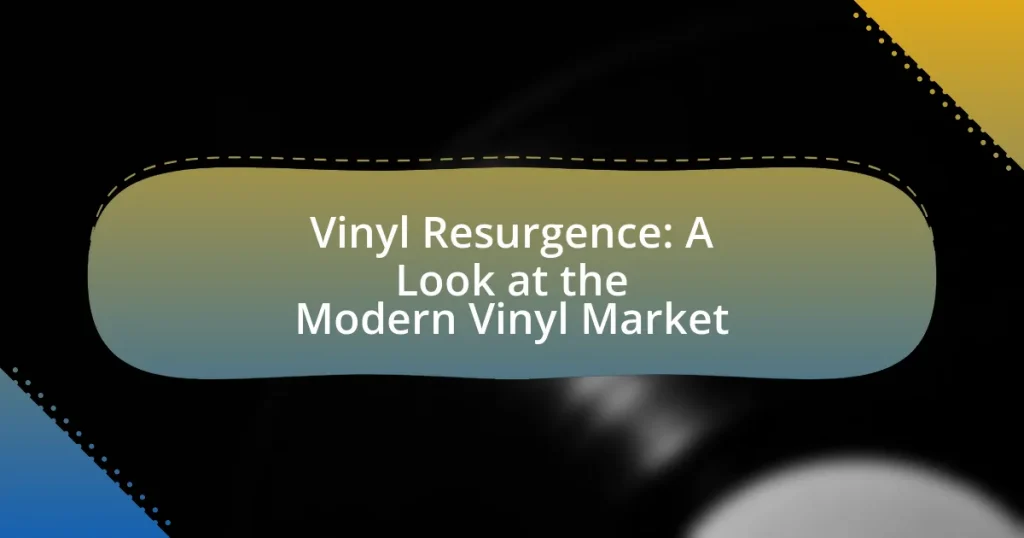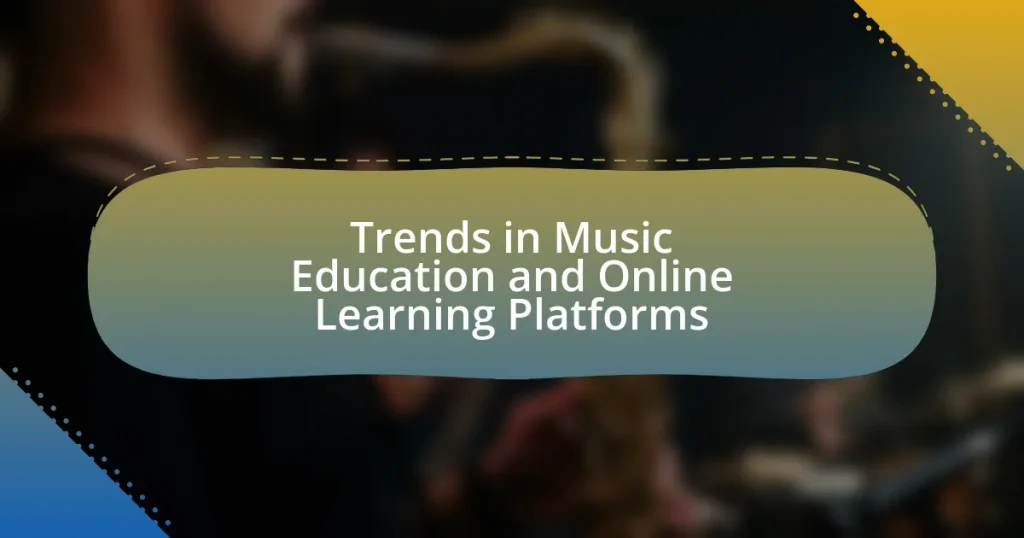The article “Revolutionizing Sound: Artists Using Technology to Innovate” explores how technological advancements are transforming sound creation and artistic expression. It highlights the role of digital audio workstations, synthesizers, and artificial intelligence in enabling artists to redefine music production and push creative boundaries. Key topics include the impact of immersive technologies like virtual reality and augmented reality on sound experiences, the significance of audio interfaces, and the benefits of using virtual instruments in sound design. Additionally, the article discusses strategies for emerging artists to leverage technology for wider audience reach and the ethical considerations in using digital tools.
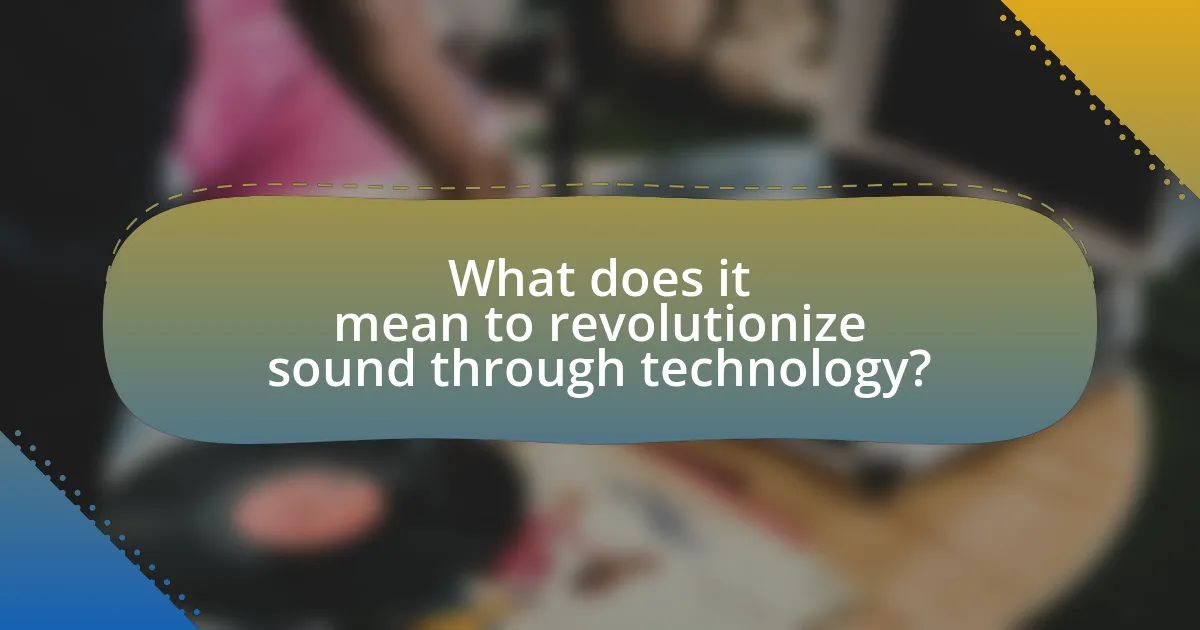
What does it mean to revolutionize sound through technology?
Revolutionizing sound through technology means fundamentally transforming how sound is created, manipulated, and experienced using advanced technological tools and methods. This transformation can include innovations such as digital audio workstations, synthesizers, and immersive audio formats like spatial sound, which allow artists to explore new sonic possibilities. For instance, the introduction of MIDI technology in the 1980s enabled musicians to control multiple instruments and software, significantly expanding creative options. Additionally, advancements in artificial intelligence and machine learning are now enabling real-time sound processing and composition, further pushing the boundaries of musical expression.
How are artists redefining sound in the digital age?
Artists are redefining sound in the digital age by leveraging technology to create innovative music experiences. They utilize digital audio workstations, software synthesizers, and artificial intelligence to manipulate sound in unprecedented ways. For example, artists like Grimes and Amon Tobin employ complex algorithms and machine learning to generate unique soundscapes, pushing the boundaries of traditional music production. Additionally, platforms like SoundCloud and Bandcamp enable independent artists to distribute their work globally, fostering diverse musical styles and collaborations that were previously unattainable. This technological integration not only enhances creativity but also democratizes music production, allowing a broader range of voices to be heard in the industry.
What technological advancements are influencing sound creation?
Technological advancements such as digital audio workstations (DAWs), synthesizers, and artificial intelligence (AI) are significantly influencing sound creation. DAWs like Ableton Live and Logic Pro enable artists to compose, edit, and produce music with unprecedented flexibility and efficiency. Synthesizers, both hardware and software, allow for the generation of a wide range of sounds, expanding the sonic palette available to creators. AI technologies, including machine learning algorithms, are being utilized to analyze musical patterns and generate new compositions, thereby transforming traditional methods of sound creation. These advancements have democratized music production, making it accessible to a broader range of artists and fostering innovation in the industry.
How do these advancements change the way music is produced?
Advancements in technology significantly change the way music is produced by enabling artists to access sophisticated tools and platforms that streamline the creative process. Digital audio workstations (DAWs), for instance, allow for intricate editing, mixing, and mastering, which were previously time-consuming and required extensive hardware. Additionally, the rise of artificial intelligence in music production facilitates automated composition and sound design, enhancing creativity and efficiency. According to a 2021 report by the International Federation of the Phonographic Industry, 70% of music producers now utilize AI tools, demonstrating a shift towards technology-driven production methods. These advancements not only democratize music creation, allowing independent artists to produce high-quality tracks without major label support, but also foster innovation in sound, leading to new genres and styles.
Why is technology essential for modern artists?
Technology is essential for modern artists because it enables innovative creation, enhances accessibility, and expands distribution channels. Artists utilize digital tools and software to produce complex works that were previously unattainable, such as electronic music and digital art. For instance, the use of software like Ableton Live allows musicians to manipulate sound in real-time, creating unique compositions that push artistic boundaries. Furthermore, technology facilitates access to a global audience through platforms like social media and streaming services, allowing artists to share their work widely and connect with fans directly. This shift has been supported by statistics showing that over 60% of artists now rely on digital platforms for promotion and sales, highlighting technology’s critical role in the modern art landscape.
What role does technology play in artistic expression?
Technology serves as a crucial facilitator of artistic expression by providing new tools and mediums for creativity. Artists leverage technology to create innovative works that push the boundaries of traditional art forms, such as digital painting, music production software, and interactive installations. For instance, the rise of digital audio workstations has transformed music composition, allowing artists to experiment with sound in ways that were previously impossible. Additionally, technologies like virtual reality and augmented reality enable immersive experiences that engage audiences on multiple sensory levels, enhancing the overall impact of the artwork. This integration of technology not only expands the possibilities for artistic creation but also democratizes access to art-making tools, allowing a broader range of voices to contribute to the artistic landscape.
How does technology enhance collaboration among artists?
Technology enhances collaboration among artists by providing platforms and tools that facilitate real-time communication and creative sharing. For instance, cloud-based software allows multiple artists to work on a project simultaneously, regardless of their geographical locations, thus breaking down traditional barriers to collaboration. Additionally, social media and online communities enable artists to connect, share ideas, and receive feedback instantly, fostering a collaborative environment. Research indicates that 70% of artists report improved collaboration through digital tools, highlighting the significant impact of technology on creative partnerships.
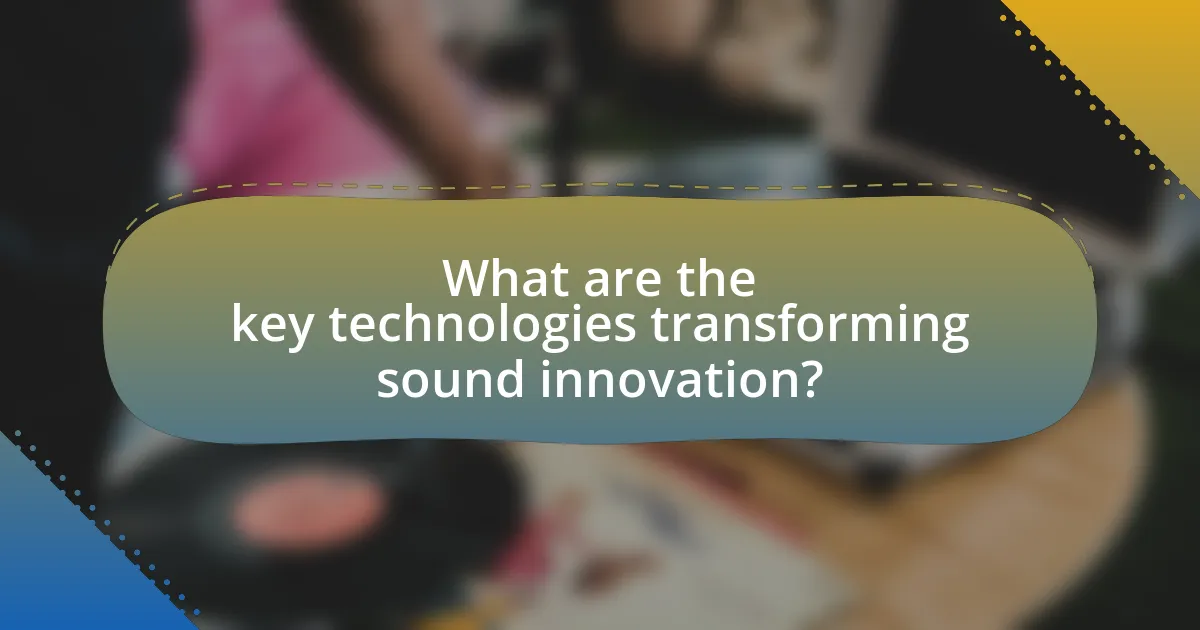
What are the key technologies transforming sound innovation?
Key technologies transforming sound innovation include artificial intelligence, spatial audio, and immersive sound technologies. Artificial intelligence enables music composition and sound design through algorithms that analyze patterns and generate new audio experiences. Spatial audio technology enhances the listening experience by creating a three-dimensional sound environment, allowing users to perceive sound from various directions, which is increasingly utilized in virtual reality and gaming. Immersive sound technologies, such as Dolby Atmos, provide a more engaging auditory experience by allowing sound to move freely in a three-dimensional space, enhancing storytelling in film and music. These technologies collectively reshape how artists create and audiences experience sound, driving innovation in the industry.
Which software tools are most popular among sound artists?
The most popular software tools among sound artists include Ableton Live, Pro Tools, and Logic Pro. Ableton Live is favored for its intuitive interface and real-time performance capabilities, making it ideal for live sound manipulation. Pro Tools is recognized as the industry standard for audio editing and mixing, offering advanced features for professional sound production. Logic Pro is preferred for its comprehensive suite of virtual instruments and effects, catering to music composition and sound design. These tools are widely used in the sound art community, as evidenced by their prevalence in professional studios and educational institutions.
How do digital audio workstations (DAWs) facilitate creativity?
Digital audio workstations (DAWs) facilitate creativity by providing a comprehensive platform for music production, enabling artists to compose, edit, and mix audio with ease. DAWs offer a range of tools such as virtual instruments, effects, and MIDI capabilities, which allow musicians to experiment with sound in innovative ways. For instance, the integration of loop libraries and sample packs within DAWs encourages users to explore diverse musical styles and textures, enhancing their creative output. Additionally, features like automation and non-destructive editing empower artists to refine their work without losing original ideas, fostering a more dynamic creative process. The accessibility of DAWs has democratized music production, allowing a wider range of individuals to express their creativity regardless of their technical background.
What are the benefits of using virtual instruments in sound design?
The benefits of using virtual instruments in sound design include enhanced creativity, accessibility, and versatility. Virtual instruments allow sound designers to explore a vast array of sounds and textures that may be difficult or impossible to achieve with traditional instruments. For instance, software synthesizers can emulate complex analog sounds and provide unique sound manipulation options, which can lead to innovative compositions. Additionally, virtual instruments are often more affordable than physical instruments, making high-quality sound design accessible to a broader range of artists. Furthermore, they offer the convenience of portability and ease of integration into digital audio workstations, streamlining the production process.
What hardware innovations are impacting sound production?
Hardware innovations impacting sound production include digital audio interfaces, advanced synthesizers, and high-resolution audio converters. Digital audio interfaces enhance connectivity and audio quality, allowing for seamless integration between instruments and computers. Advanced synthesizers, such as modular and software-based systems, provide artists with unprecedented sound design capabilities, enabling the creation of unique audio textures. High-resolution audio converters improve the fidelity of sound reproduction, ensuring that the nuances of recordings are preserved. These innovations collectively enhance the creative process for artists, facilitating new forms of expression in music production.
How do synthesizers contribute to sound experimentation?
Synthesizers significantly contribute to sound experimentation by allowing musicians to create and manipulate sounds in ways that traditional instruments cannot. They enable the generation of a wide range of tones, textures, and effects through various synthesis methods such as subtractive, additive, and granular synthesis. For instance, the Moog synthesizer, developed in the 1960s, revolutionized music by introducing new sound possibilities that led to the emergence of genres like electronic and synth-pop. This capability for sound design has been pivotal in experimental music, as artists can explore uncharted auditory landscapes, pushing the boundaries of creativity and innovation in sound.
What is the significance of audio interfaces in modern music?
Audio interfaces are crucial in modern music as they serve as the bridge between musical instruments or microphones and computers, enabling high-quality audio recording and playback. They convert analog signals into digital data, allowing musicians to capture sound with precision and clarity, which is essential for professional music production. The significance is underscored by the fact that many audio interfaces now support high sample rates and bit depths, enhancing the fidelity of recordings. Additionally, they often include features like MIDI connectivity and built-in preamps, which further streamline the recording process and expand creative possibilities for artists. This technological advancement has democratized music production, making it accessible to a wider range of creators, from hobbyists to professionals.

How are artists using technology to push creative boundaries?
Artists are using technology to push creative boundaries by integrating digital tools, software, and innovative platforms into their creative processes. For instance, musicians are utilizing software like Ableton Live and Pro Tools to manipulate sound in ways that were previously impossible, allowing for the creation of complex compositions and unique soundscapes. Visual artists are employing augmented reality (AR) and virtual reality (VR) to create immersive experiences that engage audiences in novel ways, as seen in projects like the “The Night Cafe” VR experience, which reimagines Vincent van Gogh’s artwork in a 3D environment. Additionally, generative art, powered by algorithms and artificial intelligence, enables artists to explore new aesthetics and forms, exemplified by works created using platforms like Processing and OpenFrameworks. These technological advancements not only enhance artistic expression but also expand the possibilities of audience interaction and engagement.
What are some notable examples of artists innovating with technology?
Notable examples of artists innovating with technology include Björk, who utilizes virtual reality and interactive installations in her performances, and Brian Eno, known for his pioneering work in ambient music and generative art through software. Additionally, the electronic music duo Daft Punk has integrated robotics and visual technology into their live shows, enhancing audience engagement. These artists exemplify the intersection of creativity and technology, pushing the boundaries of traditional art forms.
How has the use of AI changed the landscape of music creation?
The use of AI has significantly transformed the landscape of music creation by enabling artists to generate, compose, and produce music more efficiently and creatively. AI algorithms can analyze vast amounts of musical data, allowing for the creation of unique compositions that blend various genres and styles. For instance, platforms like OpenAI’s MuseNet and Google’s Magenta utilize machine learning to compose original pieces, demonstrating AI’s capability to assist in the creative process. Additionally, AI tools can automate repetitive tasks in music production, such as mixing and mastering, which streamlines workflows and allows artists to focus on the creative aspects of their work. This shift has led to a democratization of music creation, where individuals without formal training can produce high-quality music using AI-driven software.
What impact do immersive technologies like VR and AR have on sound experiences?
Immersive technologies like virtual reality (VR) and augmented reality (AR) significantly enhance sound experiences by creating spatial audio environments that mimic real-world acoustics. These technologies allow users to perceive sound from multiple directions and distances, leading to a more engaging and realistic auditory experience. For instance, studies have shown that spatial audio in VR can improve user immersion by up to 30%, as it aligns sound with visual cues, making the experience more cohesive and believable. Additionally, AR applications can overlay sound in real-time onto the physical environment, allowing for interactive soundscapes that respond to user movements and actions. This integration of sound with immersive visuals not only transforms how audiences engage with audio but also opens new avenues for artists to innovate in sound design and storytelling.
How can emerging artists leverage technology for success?
Emerging artists can leverage technology for success by utilizing digital platforms for distribution, promotion, and engagement with audiences. For instance, platforms like Spotify and Apple Music allow artists to reach global audiences without traditional gatekeepers, while social media channels such as Instagram and TikTok enable direct interaction and marketing. According to a 2021 report by the International Federation of the Phonographic Industry, streaming accounted for 62% of the global recorded music revenue, highlighting the importance of digital distribution. Additionally, tools like music production software and online collaboration platforms facilitate the creation of high-quality music, allowing artists to produce and share their work more efficiently. This integration of technology not only enhances visibility but also fosters community building and fan engagement, essential for an artist’s growth in the competitive music industry.
What strategies can artists adopt to integrate technology into their work?
Artists can adopt several strategies to integrate technology into their work, including utilizing digital tools for creation, engaging with social media for promotion, and exploring interactive installations. Digital tools such as software for music production, graphic design, and video editing allow artists to expand their creative possibilities and reach new audiences. Social media platforms enable artists to showcase their work, connect with fans, and collaborate with other creators, enhancing their visibility and engagement. Interactive installations, which often incorporate augmented reality or virtual reality, provide immersive experiences that can transform traditional art forms and invite audience participation. These strategies reflect the growing trend of technology in the arts, as evidenced by the increasing number of artists who leverage these tools to innovate and redefine their practices.
How can technology help artists reach wider audiences?
Technology enables artists to reach wider audiences by providing platforms for global distribution and engagement. Digital streaming services, social media, and online marketplaces allow artists to share their work instantly with millions of potential listeners and buyers. For instance, platforms like Spotify and Apple Music have transformed music distribution, with Spotify reporting over 400 million active users as of 2023, which significantly increases an artist’s visibility. Additionally, social media platforms such as Instagram and TikTok facilitate direct interaction between artists and fans, fostering community and promoting viral content. This direct engagement can lead to increased fan bases and opportunities for collaboration, further amplifying an artist’s reach.
What best practices should artists follow when using technology?
Artists should prioritize continuous learning and adaptation when using technology. This involves staying updated with the latest tools and software relevant to their craft, which can enhance creativity and efficiency. For instance, artists can benefit from online courses and tutorials that teach new digital techniques, enabling them to incorporate innovative methods into their work. Additionally, artists should ensure they maintain a balance between technology and traditional techniques, as this can lead to a more authentic artistic expression. Research indicates that artists who blend digital and traditional methods often produce more unique and compelling works, as seen in the rise of mixed media art. Furthermore, artists must be mindful of copyright and licensing issues when using digital resources, ensuring they respect intellectual property rights to avoid legal complications.
How can artists ensure they are using technology ethically?
Artists can ensure they are using technology ethically by adhering to established guidelines and principles that promote transparency, respect for intellectual property, and social responsibility. For instance, artists should obtain proper licenses for any software, samples, or digital assets they use, which aligns with copyright laws and protects the rights of original creators. Additionally, they can engage in practices that prioritize inclusivity and accessibility, ensuring their work does not perpetuate stereotypes or harm marginalized communities. Research indicates that ethical technology use fosters trust and collaboration within the creative community, ultimately enhancing artistic innovation and societal impact.
What common pitfalls should artists avoid when incorporating technology?
Artists should avoid over-reliance on technology, which can lead to a loss of authenticity in their work. When artists depend excessively on digital tools, they may sacrifice their unique voice and creative expression, resulting in art that feels generic or lacks emotional depth. Additionally, neglecting the importance of mastering traditional techniques can hinder an artist’s ability to effectively use technology, as a strong foundation in art principles enhances the creative process. Furthermore, failing to stay updated with technological advancements can leave artists behind in a rapidly evolving landscape, limiting their ability to innovate and connect with audiences.
